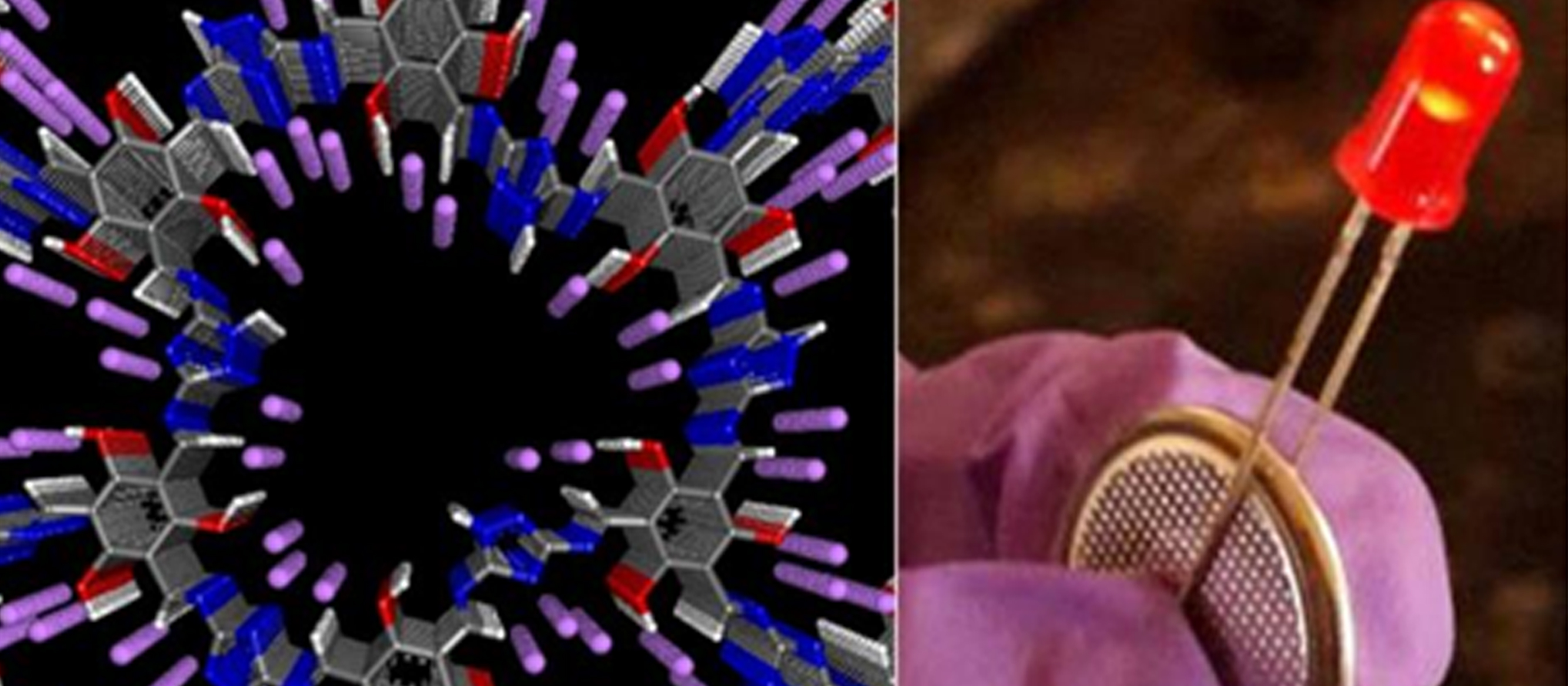 (Left) IISER-CON1 with Lithium ions in the pore (Pink- Lithium; Blue- Nitrogen, Grey- Carbon, Red- Oxygen and White- Hydrogen); (Right) A small LED being lit up by a coin-cell made with the IISERP-CON1 anode (Image Credit: R. Vaidhyanathan)[/caption]
The authors show that IISER-CON1 possesses several desirable features of graphite but with a higher energy capacity. It can accommodate Li-ions with a specific capacity of 720 mAh/g that is retained even after 1000 charge/discharge cycles. In comparison, graphite displays a specific capacity 372 mAh/g in commercial batteries.
The team attributes this higher capacity in energy storage to the structural make-up of IISER-CON1. Composition of IISER-CON1 can be tuned atom-by-atom, thereby tailor-made properties can be introduced to the material.
The current study demonstrated the potential of this covalent framework as an anode in Li-ion batteries. Authors say the key challenge is to scale up the process to use the framework in a large sized battery.
This paper titled “High and reversible lithium ion storage in self-exfoliated triazole-triformyl phloroglucinol based covalent organic nanosheets” has been accepted for publication in Advanced Energy Materials and is authored by Sattwick Haldar, Kingshuk Roy, Shyamapada Nandi, Debanjan Chakraborty, Dhanya Puthusseri, Yogesh Gawli, Satishchandra Ogale, and Ramanathan Vaidhyanathan. (Adv.Energy Mater. 2017:1702170; DOI: 10.1002/aenm.201702170).
(Left) IISER-CON1 with Lithium ions in the pore (Pink- Lithium; Blue- Nitrogen, Grey- Carbon, Red- Oxygen and White- Hydrogen); (Right) A small LED being lit up by a coin-cell made with the IISERP-CON1 anode (Image Credit: R. Vaidhyanathan)[/caption]
The authors show that IISER-CON1 possesses several desirable features of graphite but with a higher energy capacity. It can accommodate Li-ions with a specific capacity of 720 mAh/g that is retained even after 1000 charge/discharge cycles. In comparison, graphite displays a specific capacity 372 mAh/g in commercial batteries.
The team attributes this higher capacity in energy storage to the structural make-up of IISER-CON1. Composition of IISER-CON1 can be tuned atom-by-atom, thereby tailor-made properties can be introduced to the material.
The current study demonstrated the potential of this covalent framework as an anode in Li-ion batteries. Authors say the key challenge is to scale up the process to use the framework in a large sized battery.
This paper titled “High and reversible lithium ion storage in self-exfoliated triazole-triformyl phloroglucinol based covalent organic nanosheets” has been accepted for publication in Advanced Energy Materials and is authored by Sattwick Haldar, Kingshuk Roy, Shyamapada Nandi, Debanjan Chakraborty, Dhanya Puthusseri, Yogesh Gawli, Satishchandra Ogale, and Ramanathan Vaidhyanathan. (Adv.Energy Mater. 2017:1702170; DOI: 10.1002/aenm.201702170).
This research received funding from the Ministry of Human Resource Development and from DST-Nanomission, SERB and INSPIRE of the Department of Science and Technology, Government of India.
- Reported by Shanti Kalipatnapu, with inputs from R. Vaidhyanathan





